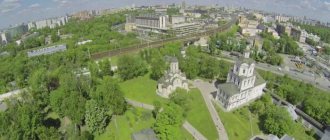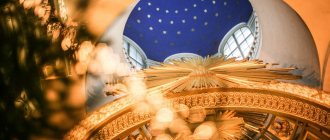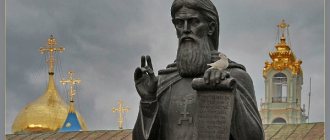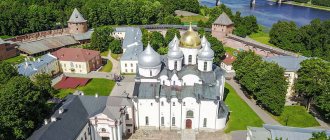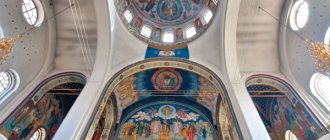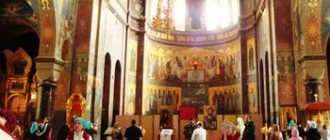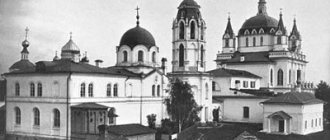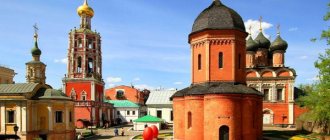History of Trinity Cathedral
Immediately after the founding of the Trinity Lavra, a small wooden church was erected on its territory, consecrated in 1340 in honor of the Holy Trinity. After this, the laurel quietly lives out its life until the beginning of the next century - and this is more than sixty years. During this time, the founder himself, St. Sergius, manages to die. This happens on the twenty-fifth of September 1392.
In 1408, a most important historical event occurred that determined the fate of the monastery: Tatar troops invaded the monastery, it was plundered and desecrated, and finally burned, by the Horde prisoner Edygei.
Most of the internal buildings, including the wooden church, were lost forever.
Despite this, the disciple and successor of Sergius of Radonezh, St. Nikon, is building the church anew.
So on September twenty-fifth, 1411, a new wooden temple was consecrated.
But the turning point was that during the construction of the church the relics of St. Sergius were found, which served as the idea for the construction of a real white-stone cathedral that would perpetuate the memory of the founder of the Trinity Monastery, who was very revered by the Moscow princes in those years. The latter pledged funds for the construction of the temple.
It began in 1422, and was completely finished in 1425. Compared to other churches in the internal ensemble of the Trinity Lavra of St. Sergius, this construction does not seem large and looks somewhat squat. Contemporaries also noted that the temple was not very tall.
Today it is difficult to say whether the decision to build such a compact structure was forced, or whether it was the personal will of St. Nikon. However, everyone who visited the cathedral, one way or another, noted the cramped interior decoration.
However, there is nothing so unusual about this: in those days, the construction of large stone churches was not particularly common at all, and the dimensions of the temple itself reached only 9 fathoms (19.2 m) in length (including the altar) and 6 fathoms (12.8 m) in width.
From the very beginning, Nikon intended to decorate the walls of the church with picturesque portraits and icons. Famous creators of those times - the monks of the Moscow Andronnikov Monastery, which, one might say, was a branch of the Trinity Church, also built by St. Nikon - undertook to paint the interior decoration of the building.
Modern research confirms that both of these great artists and icon painters participated in the creation of the iconostasis, and also attracted artists from their own circles to work; But today it is almost impossible to find out the exact origin of ancient icons.
The only thing that is known for sure is that the famous Trinity icon was 100% painted by Andrei Rublev. This icon is the main shrine of the monastery.
The October Revolution became another tragic historical phenomenon that interfered with the everyday life of the Trinity Lavra, although compared to the Tatar invasion the scale of destruction was not so large-scale.
In 1920, the Soviet government closed the cathedral, St. Sergius' shrine was opened, and the relics were removed and exposed for all to see. Historical evidence suggests that believers venerated the remains, turning their gaze away from the “nakedness” (uncovered relics).
At the same time, at the turn of the 20s-30s, there was an immediate threat of complete destruction of the holy relics, which at that time were transferred to the Moscow and Sergiev Posad museums. Anti-religious organizations, conducting ideological propaganda, threatened to cremate the sacred remains. Fortunately, the barbarity was not carried out.
After the war, the rebirth of the Trinity Cathedral began: a large-scale reconstruction was carried out, serious restoration work was carried out to restore the original appearance of the cathedral, lost during the war. The reconstruction was completed in the 60s.
And at the turn of the century, the Patriarchal Architectural and Restoration Center, created on the territory of the monastery, began to transform and improve the areas surrounding the temple. At the same time, in the cathedral itself, the facades were whitened, the roof of the quadrangle and apses was returned to normal, the gilding was restored, and much more.
Orthodox Life
The main cathedral church and the oldest surviving structure of the Trinity Monastery, the first stone building of the Lavra.
It was erected by the Monk Nikon in 1422-23. “in honor and praise” to the founder of the monastery, St. Sergius of Radonezh (†1392) on the site of the first wooden Trinity Church. The construction of the temple was carried out with the assistance of the son of Grand Duke Dmitry Ivanovich Donskoy - Prince of Zvenigorod and Galicia Yuri Dmitrievich, godson of St. Sergius. The place where the relics of the Trinity First Abbot rest is the holy of holies of the monastery.
Trinity Cathedral is a small four-pillar cross-domed church with one dome and three low apses on a high basement (part of the basement is currently covered by a cultural layer). The walls of the cathedral are made of regular blocks of white stone, their thickness and massiveness is emphasized by deep perspective portals and narrow slit-like windows. Flat wide blades give the facades a three-part division and serve as structural pilasters. The smooth walls of the cathedral end with keel-shaped zakomaras, the arched masonry of which rests on the capitals of the pilasters and is separated from the plane of the walls by an additional ledge (for the first time in Russian architecture, the original interpretation of the classical order system is used in this way). The keel-shaped shape of the zakomar is repeated by two rows of kokoshniks at the base of the dome drum, which has retained the ancient helmet-shaped shape. The only decoration of the cathedral is a wide ornamental belt of three ribbons of a skillfully carved “wicker” pattern, which adorns the facades, altar apses and the drum of the dome.
Despite its small size - the height of the temple to the top of the cross is 30 m - the cathedral creates the impression of a majestic and powerful structure. All forms of the temple are simple and compact - the apses almost do not protrude beyond the main volume and are raised to the same height, the keel-shaped arches (kokoshniks) barely rise above the facades, the walls have a significant slope inward (up to 45 cm). The harsh beauty and laconicism of the decor - white stone carved belts with repeating motifs of woven crosses and flowers - give the structure features of perfection, which the chronicler expressed with the words: “a beautiful church has been erected.”
Typologically, the Trinity Cathedral belongs to the few surviving monuments of early Moscow architecture of the late 14th - early 15th centuries, when the image of a compact one-domed court-princely temple without a vestibule emerged. The cathedrals in Zvenigorod - the Assumption on Gorodok (1400) and the Nativity of the Savvino-Storozhevsky Monastery (1405), as well as the Spassky Cathedral of the Andronikov Monastery in Moscow (1427) - belong to this type. A few early Moscow churches were created at the behest of members of the grand ducal house. The construction of one of the first white-stone cathedrals in Moscow Rus' at the Trinity Monastery testified to the historical recognition of the great significance of the personality of St. Sergius and the monastery he founded.
The interior of the cathedral is distinguished by its amazing integrity. The soft diffused light coming from above from ten (instead of the usual eight) narrow windows of the dome drum allows you to thoughtfully and leisurely contemplate the holy faces of the high five-tier iconostasis, pillar and wall icon cases, and fresco paintings. At the southern wall next to the iconostasis is the tomb of the founder of the monastery, St. Sergius. The cathedral follows the ancient Byzantine tradition of placing the reliquary with the relics of the saint in the southern part of the temple, in front of the altar, perpendicular to the iconostasis.
Design features give the monument features of unique originality. The pillars of the cathedral are strongly shifted to the east, its head is shifted towards the altar, the southern and northern portals are located closer to the apses. This architectural technique allows you to increase the space of the central nave, while at the same time making the altar part of the temple small in size. The inclination of the walls, pylons and drum of the dome towards the center of the temple, the elongated arches of the upper part of the cathedral create the impression of an increased height of the structure. The entire system of the cross-domed church here is subordinated to one task - the creation of a single, integral internal space.
The iconostasis of the Trinity Cathedral is unique. It was created at a time when in the Russian church tradition a systematically thought-out and visually integral multi-tiered iconostasis was taking shape as an image of the Heavenly City, as a manifestation of the Church of the Heavenly Church on earth. This is the only complex of the early 15th century that has been preserved in the temple for which it was intended.
The icons and frescoes of the Trinity Cathedral were made by a team of craftsmen under the leadership of St. Andrei Rublev and Daniil Cherny in 1425-1427. The Trinity icon was painted as the main temple icon “in praise of St. Sergius” - the great creation of Andrei Rublev and the most famous work of Russian icon painting in the world. The idea of the Triune God is embodied in the icon with amazing perfection. The image is full of deep meaning, reflecting the essence of the ascetic ministry of St. Sergius: “so that by looking at the Holy Trinity the hateful discord of this world will be eradicated” (since 1929, the icon has been kept in the State Tretyakov Gallery; a copy is presented in the iconostasis).
The “Trinity” icon of St. Andrei Rublev was created as a “vicar”, that is, an icon of the lower, local, tier of the iconostasis. In the Trinity Cathedral, this row of the iconostasis was formed over the course of the 15th–17th centuries. Its formation occurred simultaneously with the appearance of icons on the walls and pillars of the cathedral and was largely determined by the general process of formation and development of the liturgical space of the temple, the most important element of which was the revered shrine - the tomb with the relics of the founder of the monastery, St. Sergius of Radonezh.
In the 16th century The local row was supplemented by two icons of “the sovereign and the tsar and the Grand Duke John Vasilyevich of All Rus'’s contribution.” This is the “Trinity” icon (currently located to the left of the Royal Doors) and “the image of the local wonderworker Sergius in action, overlaid with gold.” The half-length image of St. Sergius dates back to the end of the 15th century. and refers by researchers to the works of the circle of Dionysius. This image is the earliest known hagiographic icon of St. Sergius.
Andrei Rublev “and his comrades” painted the icons of three rows of the iconostasis: the Deesis, the festive and the prophetic ranks. The Deesis rite includes fifteen icons with images of saints, including the warrior-martyrs George and Demetrius, whose images are associated with the tradition of the church-wide commemoration of fallen soldiers on Demetrius Saturday. The origins of this tradition go back to the prayer of St. Sergius of Radonezh, during which he remembered the names of the soldiers of Prince Dmitry Donskoy who died on the Kulikovo field.
In the festive row of nineteen icons on subjects of the Gospel history from the Annunciation of the Blessed Virgin Mary and the Nativity of Christ to the Dormition of the Blessed Virgin Mary, the central place is occupied by two icons “Communion of the Apostles”. The prophetic row includes six paired icons with half-length figures of prophets and is the oldest known image of prophets in the iconostasis.
In 1600, by order of Tsar Boris Fedorovich Godunov, the top tier was completed - twenty-one icons of “the forefathers with cherubs, overlaid with silver.”
In 1643, Tsar Mikhail Fedorovich “bestowed... the royal doors to the church” in a chased silver frame. The Royal Doors from the Rublevsky iconostasis were moved to the one built in 1635-1637. Church in the name of Saints Zosima and Savvaty Solovetsky (now located in the Sacristy of the Trinity-Sergius Lavra museum). In the local row of the iconostasis and on the southwestern pillar, signature icons of the famous master of the Moscow Kremlin Armory, royal isographer Simon Ushakov, have been preserved: “The Savior Not Made by Hands” (1674), “The Savior on the Throne” (1684), “The Descent of the Holy Spirit on the Apostles” ( 1682).
Unlike the iconostasis, the original murals of the Trinity Cathedral have been almost completely lost, with the exception of a small fragment in the altar of the temple. In 1635, the cathedral's frescoes were renewed, preserving the iconographic scheme of the ancient painting. In subsequent centuries, the painting was repeatedly updated and covered with new records (last time - in 2002-2004).
Until the end of the 16th century. the relics of St. Sergius were in a wooden shrine created after their miraculous discovery (currently located in the Assumption Cathedral). By 1585, by order of Tsar Ivan IV Vasilyevich and his son Fyodor Ioannovich, a silver shrine was made for the main shrine of the monastery, decorated with applied figured embossed marks with the texts of the Life of St. Sergius. In 1730-1741 By order of Empress Anna Ioannovna, a silver canopy (weighing more than 25 pounds) was made for the shrine with the relics. The hammered lid of the shrine dates back to the 19th century. Behind the glass next to the tomb are the things of the Reverend - a schema, a staff and two wooden liturgical plates. The interior decoration of the temple was modified and replenished with new precious donations over several centuries. After 1917, only the most important monuments were left in the Trinity Cathedral.
The under-dome space of the temple is illuminated by a gilded copper chandelier from the late 15th century. works of the German workshop of Fischer. The late Gothic monument with cast figures of the Savior, the Blessed Virgin Mary and the twelve apostles is one of the many contributions to the Trinity Monastery of Tsar Ivan Vasilyevich the Terrible. From a later time are chased silver frames of icons of the forefathers' rank (1778) and icon cases with pediments around the pillars (19th century).
In the altar of the cathedral, a steel gilded bishop's chair made by Tula masters of the late 18th century, donated to the Holy Archimandrite of the Trinity-Sergius Lavra, Metropolitan of Moscow Platon (Levshin), as well as a canopy made in 1809 from silver over the throne, have been preserved.
The western porch adjacent to the cathedral was first mentioned in 1584. When entering the cathedral from the porch, next to the painted portal you can see frescoes of the 16th century. with the image of Saints Sergius and Nikon of Radonezh.
The iron door leading to the southern porch retains a hole from a cannonball, received during the siege of the monastery by Polish-Lithuanian troops in 1608-1610.
In the southwestern corner of the temple there is a memorial plaque over the grave of Radonezh Prince Andrei Vladimirovich (monastically Sava).
***
Trinity Cathedral is the main temple of the Lavra. In the architectural ensemble of the Lavra, its primacy is emphasized by the gilded roof covering and the avenue that directly connects the cathedral with the Holy Gate.
The restoration of the Trinity Cathedral began in 1925 with the dismantling of the later northern porch and the restoration of the white stone masonry of the northern facade. The work was supervised by architect D.P. Sukhov. In 1926, he restored three of the five previously hewn window openings in the apses of the temple.
In 1939-40 soundings were carried out to search for traces of frescoes of the 15th century. The restoration of the fresco painting was completed in 1953.
In 1954, under the leadership of architect V.I. Baldin, the restoration of the facades of the cathedral resumed: they were cleared of the canvas and oil paintings of the 18th-19th centuries pasted on them, and the ancient forms of the portals and window openings were restored. In 1966, this stage of restoration was completed by restoring the mosquito cover.
Based on materials from stsl.ru
Current status of Trinity Cathedral
Trinity Cathedral of the Trinity of Sergius Monastery is considered one of the existing cathedrals in Russia. Every day, when Lent is not in progress, prayers and services are held here, including the Divine Liturgy, as well as a prayer service with an akathist to St. Sergius of Radonezh at the shrine with relics.
On Friday, at 5 o'clock in the afternoon, temple prayers are held here with an akathist to the Mother of God on the date of her appearance to the founder. In Nikon's chapel, erected over Nikon's grave, services are held every November 30th - this is the day of remembrance of St. Nikon, abbot of Radonezh, wonderworker.
The Trinity Church, the Zapadenskaya porch, Nikon's chapel and the Serapifon's tent, adjacent to the Nikon's chapel, are the most valuable objects of the historical heritage of all the peoples of Russia, as well as urban planning monuments of the Fed. meaning as a separate unit of the architectural ensemble of the Trinity Monastery.
In 1993, the UN World Heritage Committee included the archaeological ensemble of the monastery on the UNESCO list of world heritage sites.
Architecture of Trinity Cathedral
The main purpose of the construction of the cathedral, as conceived by Nikon, was to imprint the memory of Sergius. Therefore, the white-stone, golden-domed structure, built over the ashes of the founder of the Trinity Monastery, was completed sparing no expense, although without extreme extravagance.
Ornament on the apse of the Trinity Cathedral of the Holy Trinity Sergius Lavra.
Money for construction was not a problem, because the Trinity Lavra of St. Sergius was popular with many Moscow princes, who respected the memory of the saint and were ready to spend any money to perpetuate him.
A huge role was played by the Prince of Moscow Dmitry Donskoy, baptized, by the way, by Sergius of Radonezh himself, who in the future became the winner of the Battle of Kulikovo and the savior of the Russian land. Thus, considerable efforts were devoted to the construction of the cathedral.
The temple was built in the usual style of Moscow church architecture of those times, the end of the 14th - beginning of the 4th centuries, which was characterized by the absence of a vestibule and a large single-domed dome crowning the building.
At the same time, the temple has interesting architectural features that were not typical for this style: the division of the facades did not correspond to the temple space, the round drum with a dome-helmet crowning it is shifted towards the altar.
Although the entire building is structurally not very large, its walls are formed in this way (with all these curlicues, kokoshniks and other decorations), creating an external effect of scale and visually enlarging the cathedral. This applies to both the interior and exterior.
The inside of the building was painted by the best representatives of icon painting of those times: for example, the great icon painters Andrei Rublev and Daniil Cherny took part in the painting.
The history of the Trinity Cathedral of the Trinity-Sergius Monastery is closely connected with numerous reconstructions and external changes. This is due, first of all, to the extraordinary popularity of the temple among the country's top officials.
For example, in 1510, Prince Vasily III of Vladimir and Moscow, after a successful campaign against Pskov, ordered the roof of the cathedral to be covered with iron. And Tsar Ivan IV, during a prayer service after the capture of Kazan in 1552, ordered the dome to be gilded.
Over the next centuries, various chapels were added to the cathedral: a crypt, a refectory, and Nikon's chapel. Already in the 18th century, reconstruction was carried out again: the roof was replaced, the facades were repainted, and the interior design was also regularly changed. Thus, the temple constantly changed its appearance.
Architecture
Izmailovsky Cathedral is a large building with five domes , built in the Empire style. Its height is more than 80 meters. On the facades there are six-column porticoes, in the niches there are figurines of angels made of bronze.
In 1836, marble plaques with the names of officers who died in the battles of Austerlitz, Kulme and Friedland were hung on the walls. The main dome of the cathedral is visible from anywhere in the city at a distance of 20 kilometers.
Tradition says that the blue color of the domes was chosen according to the color of the Izmailovo uniforms
Interior decoration
Inside, the Izmailovsky Cathedral is bright and spacious. The main dome of the cathedral is raised up by four Corinthian columns, it seems to be floating in the air. Turkish banners hung on the walls of the cathedral, reminding of victory in the war with God's help. In 2005, the Column of Glory was restored in front of the shrine, the basis of which is captured Turkish cannons.
Iconostasis of the Trinity Cathedral
The Trinity Cathedral iconostasis is a unique item of church historical heritage. Multi-tiered (five-tiered) iconostasis of exceptional historical value. The most valuable works placed in the iconostasis were created by masters under the leadership of Andrei Rublev and Danila Cherny.
The most important, famous and key work of Andrei Rublev, which is also indicated in chronicle sources, is the world famous icon “Trinity”. On it, the legendary icon painter stunningly embodies the image of the triune god. A number of researchers believe that Andrei’s authorship belongs to 2 to 5 works moved to the iconostasis.
These include displays:
- apostles Paul and Peter;
- Archangel Gabriel;
- Demetrius of Thessalonica from the Deisis series;
- as well as the “Baptism” icon.
Iconostasis of the Trinity Cathedral of the Trinity Sergius Monastery
It is believed that the icons of the apostles are closest to the “Trinity” in artistic style, therefore they are recognized as the main candidates for recognition of Rublev’s authorship. In total, the iconostasis of the Lavra contains seventy-four icons.
Since three icons of the Zvenigorod rank, attributed to Rublev, and Rublev’s works of the iconostasis of the Vladimir Assumption Cathedral are placed in the Tretyakov Gallery, the Holy Trinity Cathedral remains the only temple that preserves icons, if not of St. Andrew himself, then at least of his close circle, directly in the very temple.
Brief description of the cathedral (from history)
The battalions of the Izmailovsky Regiment were transferred from Moscow to St. Petersburg by 1734 and, by decision of the Commission on the St. Petersburg Building, were stationed on the Fontanka River. The first regimental church, built in 1756, was wooden. Five-domed, with side domes, the original composition was preserved in the future.
Due to the flood of 1824, the church, which had fallen into disrepair over almost a century, was severely damaged. The design of the new temple, strong and made of stone, was drawn up by the architect Vasily Stasov. The ceremonial foundation stone for the future Trinity Cathedral took place in May 1828, in the presence of members of the royal family.
Money for construction was allocated from the state treasury and personal funds of Nicholas I - he patronized the Izmailovsky regiment even before ascending the throne.
The misfortunes that befell the architectural monument during the history of its existence were not limited to one flood. In 1834, due to another natural disaster, an accident occurred - damaging the metal structures, the hurricane tore off the central dome. The new one, with a wooden base, was designed by Pyotr Petrovich (aka Pierre-Dominique) Bazin, a French-Russian engineer. In 1835, the finishing was finally completed, and Metropolitan Philaret of Moscow consecrated the temple on the eve of the Feast of the Holy Trinity.
Trinity Cathedral in St. Petersburg
In the Trinity-Izmailovsky Cathedral in St. Petersburg in 1867, the writer Fyodor Dostoevsky married his second wife, Anna Snitkina; In 1894, the funeral service for the famous Russian composer Anton Rubinstein was held there. Soon a revolution thundered, and services in the temple stopped, and all valuables were taken away. In the 30s In the 20th century, the question of demolishing or constructing a crematorium in the cathedral building was raised.
In 1938, the temple was closed; its premises were used as warehouses for a long time. During the Great Patriotic War, the Trinity Cathedral suffered more than ever: one of the side domes was destroyed, glass was broken under shelling and the walls were damaged, and there was water in the basement. Restoration was carried out more than once, and the temple began to acquire its former appearance in the 60s, when the domes were repainted from black again to bright blue.
Services resumed in 1990, when the Trinity Cathedral in St. Petersburg was returned to the Russian Orthodox Church. Another natural disaster struck the temple in 2006: a fire broke out on the scaffolding installed around the largest dome, ultimately destroying the wooden structures located in the center - exactly those that were approved during reconstruction after the storm almost two centuries ago. The parishioners who attended the service were successfully evacuated. The version of deliberate arson put forward by the former Metropolitan of St. Petersburg and Ladoga Vladimir was not confirmed.
Izmailovsky Cathedral
Shrines of the Trinity Cathedral
The Trinity Cathedral of the Trinity of Sergius Monastery remains home to a number of Orthodox shrines. Among them are the relics of Sergius of Radonezh, the prayer hall is decorated with a colossal copper chandelier of the 15th century, and a steel bishop’s chair of the 18th century is kept in the Altar.
About the relics, it should be said that at first they were placed in a modest wooden shrine. However, when problems arose with the wooden material, in the 16th century, the production of a large, heavy silver shrine began. And in the 19th century, a lid was built for it.
The gilded copper chandelier decorating the temple space was donated to the temple by Ivan IV. The chandelier is richly decorated with images of the Virgin Mary, apostles and angels
Another shrine of the temple appeared in the 18th century: Metropolitan Platon was given a gilded steel chair made by Tula craftsmen on a special order. The chair was transferred to the temple and remains here to this day as a shrine.
Trinity Cathedral in the center of the spiritual and secular life of Pskov
Since the time of Vsevolod Mstislavich, the Trinity Church has played a vital role in the life of the emerging Pskov Republic, since 1136, that is, since the collapse of Kievan Rus, which was only nominally dependent on Novgorod. A veche gathered next to the temple, a veche bell hung on the cathedral bell, the most important documents of the republic and its treasury were kept in the cathedral, and the Pskov princes swore allegiance to Pskov here... Finally, from 1192, when the relics of the holy Prince Vsevolod (Gabriel) were transferred to the Trinity Cathedral , the temple served as a princely tomb.
All major historical events in Pskov were in one way or another connected with the Trinity Cathedral. It is known that Alexander Nevsky prayed in it in 1242, after the victory in the Battle of the Ice. And in 1265, Prince Dovmont, a fugitive from Lithuania, was baptized here with the name Timofey, whose long reign in Pskov was the most important era that established Pskov statehood and marked the beginning of the rise of the Pskov Republic.
Interesting facts and legends
The Trinity Cathedral of the Trinity of Sergius Monastery is surrounded by the most interesting myths and legends.
The story, the authenticity of which cannot be reliably established, according to apocryphal sources, occurred after several clergy and members of the parish, under the leadership of the monastery minister Father Pavel Florensky, as well as lay art critic Yuri Olsufiev, learned about the impending desecration of the shrine and fearing a terrible outcome, according to With the blessing of Patriarch Tikhon, they decided to enter the cathedral and steal the head of Sergius of Radonezh, replacing it with a skull from the family crypt of the Trubetskoy family, which was located on the territory of the monastery...
According to another version, the conspirators carried out the plan to steal the head of St. Sergius in 1920, after the relics were put on public display.
The head of the founder of the monastery was transported to the sacristy, after which Yuri Olsufiev, who lived in Sergiev Posad, left the shrine for preservation at his home, where it remained until 1928, until it was buried by him in the garden.
The persecution of the authorities forced him to flee, but he managed to convey what only Olsufiev himself knew - the address and location of the sacred relic - to Novgorodian Pavel Ogurtsov (in the future - Novgorod Bishop Sergius), who became a member of the sacred mission.
Pavel Ogurtsov did not renounce his mission and came to the indicated place, to the Olsufiev estate in Sergiev Posad, where he found the designated place in the garden and dug up a great treasure - an oak casket in which the head of St. Sergius was kept.
You need to understand that all active participants in the resistance were sooner or later caught and punished. The first was Father Pavel Florensky, convicted in 1933, and in 1938 Olsufiev was sent to prison.
The main custodian of the sacred object remained P. Ogurtsov, who, on the eve of his departure to the front, transported the head to the village of Vinogradovo, in the urban district of Mytyshchi.
However, even before the start of the Second World War, the relics were returned to the shrine and were transferred to the Trinity Cathedral, but the cathedral itself at that time was simply part of the exhibition of the Zagorsk Historical Museum. However, at the end of the war, the Soviet government noticeably softened its attitude towards the Lavra and already in 1946 the monastery was reopened, and later the relics of St. Sergius were returned there.
Then, on Easter, a heavy shrine with relics, which weighed up to sixty pounds, was dragged on one hand to the Assumption Cathedral and the first service in a long time was held. Thus, the Trinity-Sergius Lavra finally returned to the fold of the Russian Orthodox Church.
How to get there
The cathedral is located in the historical center of Pskov, on the territory of the Pskov Kremlin, north of the Olginsky Bridge over the Velikaya River. The Kremlin territory is a pedestrian zone where entry of any vehicles is prohibited.
You can get to the Kremlin by public transport (stop “Lenin Square”):
- Buses: 1, 7, 7A, 11, 15, 18, 19, 25, 30;
- Minibuses: 4A, 51, 51A.
Address: Pskov, Pskov Kremlin, 1.
Schedule of services
The cathedral is open every day from 05:00 to 21:00. Here the Divine Liturgy is held daily (starts at 6:30, with the exception of weekdays during Great Lent - on days of fasting all services are transferred to the Assumption Cathedral, on weekends), an akathist prayer service at the relics of St. Radonezh (held from 05:30 to 20: thirty).
If you want to get into the Serapion Chamber or Nikonov Chapel, then you need to negotiate individually. It is also possible to get into the limit together with an organized tourist group - for this you need to submit an appropriate application.
Weekdays:
| Time | Service |
| 5:30 | prayer service at the saint's shrine. Sergius and the Midnight Office |
| 6:15 | early liturgy |
| 9:30 | late Liturgy |
| 16:45 | evening service |
Friday:
| 17:00 | prayers with akathist to the Virgin Mary | just not during the all-night vigil |
Resurrection:
| Time | Service |
| 5:30 | early liturgy |
| 6:20 | middle liturgy |
| 17:20 | prayers with akathist to St. Sergius |
| 17:20 | all-night vigil |
The Trinity Cathedral of the Trinity of Sergius Monastery regularly conducts excursions and is a popular destination among pilgrims and tourists from all over the world. Despite the busy schedule of services, the monastery always welcomes guests.
Article design: Vladimir the Great
Abbots
- Varlaam (Vysotsky) (1735 - 1737)
- Veniamin (Krasnopevkov-Rumovsky) (January 16, 1774 - July 13, 1774)
- Joasaph (Zabolotsky) (February 1, 1778 - 1782)
- Innokenty (Polyansky) (May 27, 1787 - June 29, 1788)
- Arseny (Todorsky) (May 22 - December 16, 1792)
- Dosifey (Ilyin) (January 31, 1793 - 1795)
- Theophylact (Rusanov) (May 25, 1796 - 1798)
- Ambrose (Protasov) (November 29, 1798 - January 8, 1800)
- Augustine (Sakharov) (1804 - 1806)
- Anatoly (Maksimovich) (August 25, 1809 - 1812)
- Methodius (Pishnyachevsky) (1812 - September 21, 1813)
- St. Ignatius (Brianchaninov) (1833 - 1857)
- Ignatius (Malyshev) (1857 - 1897)
- Varlaam (Nikiforov) (1897 - December 8, 1901)
- Mikhail (Gorelyshev) (1901 - May 6, 1915)
- Sschmch. Sergius (Druzhinin) (May 6, 1915 - February 19, 1919)
- Joasaph (Merkulov) (1919 [3] - ?)
- Nikolay (Paramonov) (mentioned 1993)
….
